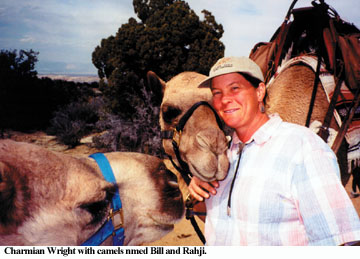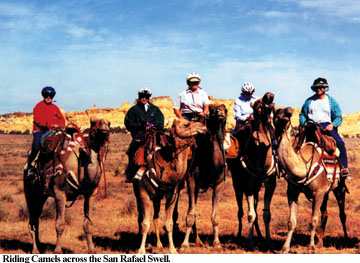 By Reece Stein KUTV Outdoors Reporter
By Reece Stein KUTV Outdoors Reporter
F orget everything you've ever heard about camels. They don't spit. They don't stink. They are gentle and fun to ride. At least Charmian Wright's camels are. Dr. Wright -- a Park City veterinarian, operates Park City Camel Ventures. In September, she takes paying customers on a three-day trek into the spectacular desert canyons of the San Rafael Swell.
"Our customers go away from here really caring about camels, being totally attached to camels because they see how awesome they are, how great they are, how wonderful they are to be around." Charmian likes her camels.
Charmian likes her camels.
 So do clients such as Shirley Stephenson, who came from New Hampshire just to ride camels. "He does whatever I want him to. He doesn't try to run away or do anything that scares me half to death. He's good natured and beautiful, I think," she says.
So do clients such as Shirley Stephenson, who came from New Hampshire just to ride camels. "He does whatever I want him to. He doesn't try to run away or do anything that scares me half to death. He's good natured and beautiful, I think," she says.
Shirley's sister, Dottie Weaver, a horse owner from Torrey, Utah, agrees. "They are well behaved, well mannered. They're not as volatile as horses but are very dependable. They have a gentle rocking way of walking. Horses can be jarring when they walk fast. These are nice guys, they're fun."
Shirley and Dottie, Rose Wright and John Criner of California each paid $1075 for their humpback odyssey in the southern Utah desert. Since we get to drive our own camels, rather than be led, the first morning begins with Camel Riding 101.
"Tell him 'Hut' and be firm," Charmian tells Shirley. Hut means get up.
"Pull back on the reigns," says Charmian as Clyde struggles from the kneeling to standing position. Shirley leans back, hanging onto a bar across the front of her saddle as Clyde raises his rear end first, then unfurls his gangly front legs, grunts and groans and finally finds his footing. "You are up so high!" she amazes. "If I don't stay on I've had it." Shirley, like the rest of us, wears a protective helmet.
"Hoosh, Clyde!" commands Shirley. Hoosh means down, but Clyde doesn't budge. He's a teenager, what do you expect. Charmian shows her how to gently urge him to the ground with the reigns. The reigns are attached to a clip, which has been pierced into the side of the camels' nose. The animals don't respond to neck reigning as a horse does. You gently pull on the reigns to steer and after a few tries we get then hang of it.
"Walk up" means giddy-up and giddy-up we do through some pretty spectacular country.
"It's beautiful," says Craner. "The canyon walls are just great, must be a couple of hundred feet high. And it's even better when you're eight feet off the ground on the back of a camel."
The first day is an easy 12-mile trek from the Head of the Sinbad, under I-70, with a brief stop at some beautiful pictographs. Lunch is high on a ridge overlooking the San Rafael Swell and Manti Mountain to the north and east. Pinion and juniper trees protect us from the strong south wind Emery County is famous for.
"It's lovely," says Rose Wright of Morgan Hill, California. "They are wonderful four-wheel-drive vehicles, they go into compound low and just go up these rises and over the rocks so nicely."
Dr. Wright says the camels are easier on the land than horses or certainly wheeled vehicles, because they have soft, padded feet. "Their footprints are erased with the next wind," she says.
"It's a completely different feel," says Weaver, comparing camels to her more familiar horses. "They are quieter. It's like they have bedroom slippers on when going over the rocks."
The second and third days are longer trips into the Swell, including a spectacular 23 miler through Eagle Canyon.
"I've wanted camels since I was a kid," says Charmian as she stands between her beloved Quasimoto, Rahji, Bill and Sefa. There are six camels on this safari; she has at least one more back home. "I've always been enchanted by them."
Most of her camels are from commercial farms in California and Missouri. But Rahji was one of the thousands of wild camels which roam the Australian out-back. They were imported from Afghanistan and are perfectly suited to the vast waterless spaces of the island nation. As many as 100,000 camels may now roam wild and are periodically rounded up and adopted out.
Charmian struck gold with Rahji. She was pregnant with Sefa who, at the age of seven, has become one of her best lead camels. Since camels are herd animals, a good leader is important to a successful trek. Charmian is a self-taught camel trainer.
"You can go places [in Utah] you'd have a tough time going with a horse," says Charmian. "Not because of the terrain but because of the lack of water. They are really suited to this kind of country," she says. In the winter the camels develop a thick coat and stay indoors, although Charmian does rent them out for parties, nativity scenes and movie props. You saw her camels in Independence Day.
The camels are back home for the winter, but Charmain will be out trekking again next September. For more information and reservations call Park City Camel Ventures at (435) 649-DUNE of write in care of P.O. Box 681135, Park City, UT 84068.
Hope you caught the camels on my "Roughing It" segment on KUTV sports last month. Happy trails.
(Published Nov., 1999, Utah Outdoors magazine)

